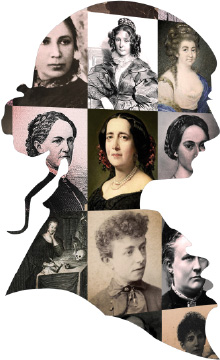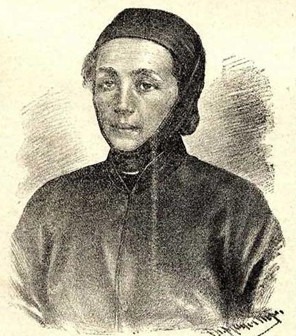Staka Skenderova
1828–1891| Date of birth | 1828 |
|---|---|
| Date of death | May 26, 1891 |
Personal situation
Staka Skenderova comes from the old Damjanović (Petrović) family, called Skenderijaši after the Turkish name for Skadar Sanjak, from where this family moved first to Komaran and Prijepolje at the beginning of the 19th century, and then to Sarajevo. Staka’s birthyear and birthplace are not determined. Some believe she could have been born in 1821 in Prijepolje. However, it is mostly believed that she was born in Sarajevo in 1828, while Celia Hawkesworth even lists 1831 as the year of her birth. Upon moving to Sarajevo, her father Pero soon died, while her brother Ilija, who was a leatherworker, started taking care of his mother Mara and sister Staka. Ilija spoke Turkish and he used to sew for the Turkish army and officers. Staka learnt Turkish, which would later prove to be useful. She moved through Orthodox houses, she was helpful to all, especially when she needed to intervene with the Turkish authorities or when she contributed to interpreting or making contracts with merchants and other business people.
Staka Skenderova dedicated her whole life to education and the struggle to maintain the first girls’ school in Bosnia and Herzegovina, in which she was the first teacher. Many state and foreign officials helped her in this endeavor. However, wealthy Sarajevo merchants would not help her as they had a negative attitude towards the school.
The crown of Staka’s recluse, almost ascetic life is her pilgrimage to the Holy Land. Her journey lasted a year. She briefly stayed with her benefactor Topal Osman Pasha in Tsargrad (Constantinople). He even secured her a meeting with Sultan Abdülaziz, who covered her travel costs. In Jerusalem, Skenderova was officially ordained and became a nun, even though she had lived such a life even before her pilgrimage. Staka gave presents from Jerusalem to many orthodox families in Sarajevo, and since that time, the people from Sarajevo thought of her as Hajji-Staka or Hajji Lady.
Her bold reaction to the pressures of the people of Sarajevo to ban the work of Miss Irby will forever be remembered. When this famous Englishwoman opened her first educational institution in 1869, Catholic and Orthodox citizens rebelled against this “Lutheran” school. They all saw Irby as competition, and believed that her work was an attack on their religious and national identity. Staka then publicly defended Miss Irby in the midst of the municipality offices. Thanks to her authority, the church and school authorities retracted their "Announcement to the People", in which they had asked Serbs not to send their children to the Protestant school. Time would prove Staka right – with her work and love, Miss Irby gained the hearts of the people of Sarajevo forever.
The last years of Staka’s life were marked by loneliness and poverty. She was left with no family, forgotten, with no funds for her charity work that was the center of her life. She lived with Miss Irby. Her life ended tragically when spooked horses trampled her on May 26, 1891, after a charity event for the poor. "Many people from all classes came to the procession on May 28. Our Serbian municipality gave the order, so the pupils of our Serbian schools walked in the procession with the teaching staff, as well as the pupils from the institution of our Serbian benefactor, the noble Miss Irby." (Obituary – Bosanska vila [The Bosnian Fairy], May 31, 1891)
| Place of birth | Prijepolje/Sarajevo |
|---|---|
| Place(s) of residence | Bosnia and Herzegovina and Serbia |
| Place of death | Sarajevo (Ilidža) |
| Nationality | Serbian |
| First language(s) | Serbian |
| Marital status | Single |
| Number of children | 0 |
| Social class | Middle class |
| Education | Educated at home and Convent education |
| Religion | Eastern orthodox |
Professional situation
The professional career of Staka Skenderova can be divided into literary and educational-humanitarian.
Staka was educated by famous Sarajevo teachers Sima and Mića Aranitović. She started going to church early.
At the initiative of the Russian consul Gilferding, Staka wrote Ljetopis Bosne 1825-1856 (Bosnian Chronicle 1825-1856) and that remains her only known work. The original was lost, but thanks to Gilferding, who included Ljetopis in his book Travels through Herzegovina, Bosnia and the Old Serbia, published in St. Petersburg in 1859, Staka’s work saw the light of day in Russia, when it was translated. In 1976, Vojislav Maksimović translated Gilferding's book into Serbian.
Celia Hawkesworth states that Gilferding gave Staka the idea to write a chronicle on the successive efforts of Bosnian viziers to smother the rebellions of Bosnian beys in Bosnia in the first half of the 19th century. The chronicle is written in the traditional form of oral epic literature which Staka knew best and which best reflected the needs of such a chronicle. It is a personal confession and historical testimony on the life in Bosnia during hard times. Staka was always at the centre of social turmoil and she wrote about it with vivacious energy, but also with bitterness, not sparing the harsh pashas, the egotistical Bosnian beys (which Serbs considered much worse than Turks), Muslim tyrants or Serbian local merchants and profiteers. Staka’s chronicle is a dramatic narrative on "violence and anarchy, suffering and desperation". The description of the merciless torture and the suffering of Staka’s younger brother Jovan is reminiscent of the descriptions of the suffering of Christian martyrs from medieval hagiographies, which Staka must have read, as well as the images of tortures of Serbian heroes from folk epic poetry. (Vojislav Maksimović) In the foreword for his book, Gilferding states that the translated manuscript is written in prose, with no interruptions, and no punctuation, adding that the author does not differentiate between prose and verse. However, where she speaks, her words fit the traditional Serbian decasyllable.
The cultural and educational work of Staka Skenderova was marked by the first girls’ school in Bosnia and Herzegovina – "St. Sava Girls’ School". Despite fierce objections, the school was founded on October 19, 1858, after Staka advocated the cause with the Russian consul, Serbian metropolitan and the Turkish authorities. Before opening the school, Staka traveled to Belgrade to acquire books and everything needed for a school. In the beginning, the school was only for Orthodox girls, but, thanks to its reputation, Muslim, Catholic and Jewish girls soon started attending it. Staka’s pupils, Ana Dizmarova and Fima became the first teachers in Mostar, while Ana Karanova and Koka Đurićeva stayed on to teach at the school. Aside from its educational role, the school also had a humanitarian role. It was a sanctuary of the socially endangered, the sick and the abandoned. Its first pupils came from poor Sarajevo families. With her selfless work, Staka soon became reputable with the poor; with her authority and knowledge of Turkish, which she used in direct negotiations with the Turkish authorities, she earned the respect of all. Staka dedicated her entire life to the benefit of the people. When Kudryavcev became the Russian consul, the Russian interest in the school dwindles. After 1870, the work of Staka’s school dwindles because there aren’t enough funds, because it lost support from several sources and because the conditions of work changed. The school is mentioned less and less in the newspapers. The last information comes from 1874, when the paper Bosna (Bosnia) writes about the success of its pupils. There is no more information later on, and it is suspected that the school was shut down by 1877. The new political reality, when the Turkish authorities were replaced by the Austrians, was not favorable for Serbian education.
| Profession(s) and other activities | humanitarian worker and social-cultural activist |
|---|---|
| Language(s) in which she wrote | Serbian |
| Financial aspects of her career | Stipend/allowance/pension |
Works by this author
Articles and other similar texts
Reception
Reception after death
Authors read by this author
* Only authors in Knjiženstvo DB are shown



